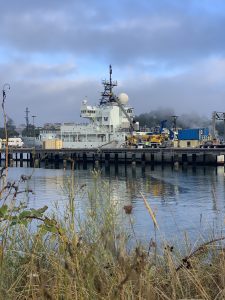

After 30 days of operations, on August 27, 2020, the Regional Cabled Array annual maintenance cruise came to a close upon completion of demobilization in Newport, Oregon. Down 10 RCA team members due to COVID, the days were especially intense, and the cruise felt longer than normal as a strict two-week quarantine period was required for all shipboard participants before the cruise started.

The cruise was once again highly successful with all objectives met. Over 350,000 lbs of gear was mobilized/demobilized. Thirteen 53 ft semi trucks moved gear between Seattle, WA and Newport, OR. During 23 days at sea, the ship transited over 1200 miles to and from Axial Seamount and all sites on the RCA were visited. Jason completed 44 dives (J2-1249 – J2-1292) to water depths of 80 m (263 ft) – 2900 m (9514 ft). During the 44 dives, 118 instruments were recovered, and 107 instruments installed back on the array, six platforms on the Shallow Profiler moorings were turned, as well as three Deep Profiler vehicles, 2 Benthic Experiment Packages, and 3 junction boxes. Thousands of meters of Deep Profiler Mooring cable were cleaned with the ROV.

As with previous cruises, the team enjoyed beautiful sunrises and sunsets, and viewing directly the stunning life forms that inhabit the seafloor (and some of our platforms that turn into oasis’s for life to colonize). Favorites included the beautiful colonies of bright colored organisms that inhabit the hydrothermal vents on Axial Seamount, supported by magmatic gases that stream from the melt-filled chambers located ~ 2 km below. It is always a gift to see the striking contrast of lavender blue protists, red-headed tube worms, and orange and white bacterial mats emerging and the ROV illuminates the darkness nearly a mile beneath the oceans’ surface. Real-time data from novel instruments in the extreme vent environments show that the system is slowly heating up, perhaps reflecting that the volcano is poised to erupt again. Spider crabs walk delicately along the glassy lava flows continually searching for food.

At Southern Hydrate Ridge, a return visit to the Pinnacle showed beautiful, pink soft coral communities that live on this 60 m tall carbonate deposit. Crabs, fish, anemones, sea stars, clams and other organisms also use the nooks and crannies as refuge and thick orange and white bacterial mats mark areas of methane seepage out of this limestone crag1: a chemoherm that has been dated at 7,300 – 11,400 years in age [1], with formation driven by chemosynthetic organisms that utilize methane and sulfide. At the Oregon Shelf site, a junction box is completely encased by beautiful sea anemones, and west of there one of the Primary Nodes has become a den for crabs.

The team worked intense long hours with 12-18 hr days common, with catch up days for sleep provided by the up to 22 hr transits out and back to Axial Seamount. The weather gods were a bit persnickety this year, resulting in several days of large swells that postponed some operations – adding to the intensity of operations. The success of this cruise highlights the amazing support and collaborative culture among the RCA, R/V Thompson and ROV Jason teams. Once again, the RCA team is very grateful to the ship and ROV personnel for their help in making this cruise such a success.

On August 31, at 10 am the last RCA gear was loaded on trucks from the logistics facility for shipping back to the UW, marking the end of this field season. No rest for the weary though as planning is already underway for next year!
[1] Teichert, B.M.A., Eisenhauer, A., Bohrmann, G., Hasse-Schramm, A., Bock, B., and Link, P. (2003) U/Th systematics and ages of authigenic carbonates from Hydrate Ridge, Cascadia Margin: Recorders of fluid flow variations. Geochimica et Cosmochimica Acta. doi:10.1016/S0016-7037(03)00128-5.
